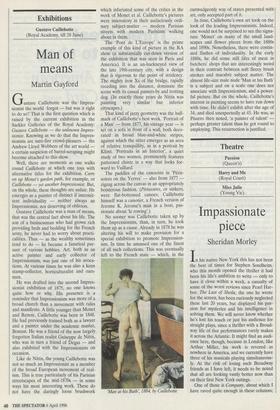Exhibitions
Gustave Caillebotte (Royal Academy, till 28 June)
Man of means
Martin Gayford
Gustave Caillebotte was the Impres- sionist the world forgot — but was it right to do so? That is the first question which is raised by the current exhibition in the Sackler Galleries of the Royal Academy: Gustave Caillebotte — the unknown Impres- sionist. Knowing as we do that the Impres- sionists are sure-fire crowd-pleasers — the Andrew Lloyd Webbers of the art world a certain suspicion of barrel-scraping might become attached to this show.
Well, there are moments as one walks round Caillebotte at which one toys with alternative titles for the exhibition. Carty on up Monet's garden path, for example, or Caillebotte — yet another Impressionist. But, on the whole, these thoughts are unfair. He emerges as a painter of distinct if intermit- tent individuality — neither always an Impressionist, nor deserving of oblivion.
Gustave Caillebotte was a man of means, that was the central fact about his life. The son of a businessman who had grown rich providing beds and bedding for the French army, he never had to worry about practi- calities. Thus — as the wealthy sometimes tend to do — he became a fanatical pur- suer of various hobbies. Art, both as an active painter and early collector of Impressionism, was just one of his avoca- tions. At various times he was also a keen stamp-collector, horticulturalist and oars- man.
He was drafted into the second Impres- sionist exhibition of 1875, no one knows quite how or why. His presence is a reminder that Impressionism was more of a broad church than a movement with rules and manifesto. A little younger than Monet and Renoir, Caillebotte was born in 1848. He had previously trained both as a lawyer and a painter under the academic master, Bonnat. He was a friend of the now largely forgotten Italian realist Guiseppe de Nittis, who was in turn a friend of Degas — and also exhibited with the Impressionists on occasion.
Like de Nittis, the young Caillebotte was not so much an Impressionist as a member of the broad European movement of real- ism. This is true particularly of his Parisian streetscapes of the mid-1870s — in some ways his most interesting work. These do not have the daringly loose brushwork which infuriated some of the critics in the work of Monet et al. Caillebotte's pictures were innovatory in their audaciously ordi- nary subject-matter — modern Parisian streets with modern Parisians walking about in them.
The 'Pont de L'Europe' is the prime example of this kind of picture in the RA show (a substantially cut-down version of the exhibition that was seen in Paris and America). It is an un-hackneyed view of the late 19th-century city, with a design that is vigorous to the point of stridency. The mighty iron Xs of the bridge, rapidly receding into the distance, dominate the scene with its casual passers-by and trotting dog. (In exactly those years de Nittis was painting very similar but inferior cityscapes.) That kind of jazzy geometry was the hall- mark of Caillebotte's best work. 'Portrait of a Man' — from 1877, his vintage year — is set on a sofa in front of a wall, both deco- rated in broad blue-and-white stripes, against which the sitter emerges as an area of relative tranquillity, as in a portrait by Klimt. 'Portraits in an Interior', a quiet study of two women, prominently features patterned chintz in a way that looks for- ward to Vuillard.
The paddles of the canoeists in 'Penis- soires on the Yerres' — also from 1877 zigzag across the canvas in an appropriately boisterous fashion. (Petissoires, or sinkers, were flat-bottomed canoes; Caillebotte himself was a canotier, a French version of Jerome K. Jerome's man in a boat, pas- sionate about 'le rowing'.) No sooner was Caillebotte taken up by the Impressionists, than, in turn, he took them up as a cause. Already in 1878 he was altering his will to make provision for a special exhibition to promote Impression- ism. In time he amassed one of the finest of all such collections. This was eventually left to the French state — which, in the Man at his Bath, 1884, by Caillebotte curmudgeonly way of states presented with art, only accepted part of it.
In time, Caillebotte's own art took on the look of the leading Impressionists. Indeed, one would not be surprised to see the signa- ture 'Monet' on many of the small land- scapes and flower pieces from the 1880s and 1890s. Nonetheless, there were contin- ued flashes of individuality. In the early 1880s, he did some still lifes of meat in butchers' shops that are interestingly weird in their contrast between soft fleecy brush strokes and macabre subject matter. The almost life-size male nude 'Man at his Bath' is a subject and on a scale one does not associate with Impressionism, and a power- ful picture. But on the whole, Caillebotte's interest in painting seems to have run down with time. He didn't exhibit after the age of 34, and died unexpectedly at 45. He was, as Pisarro then noted, 'a painter of talent' perhaps greater talent than he got round to employing. This resurrection is justified.


























































 Previous page
Previous page